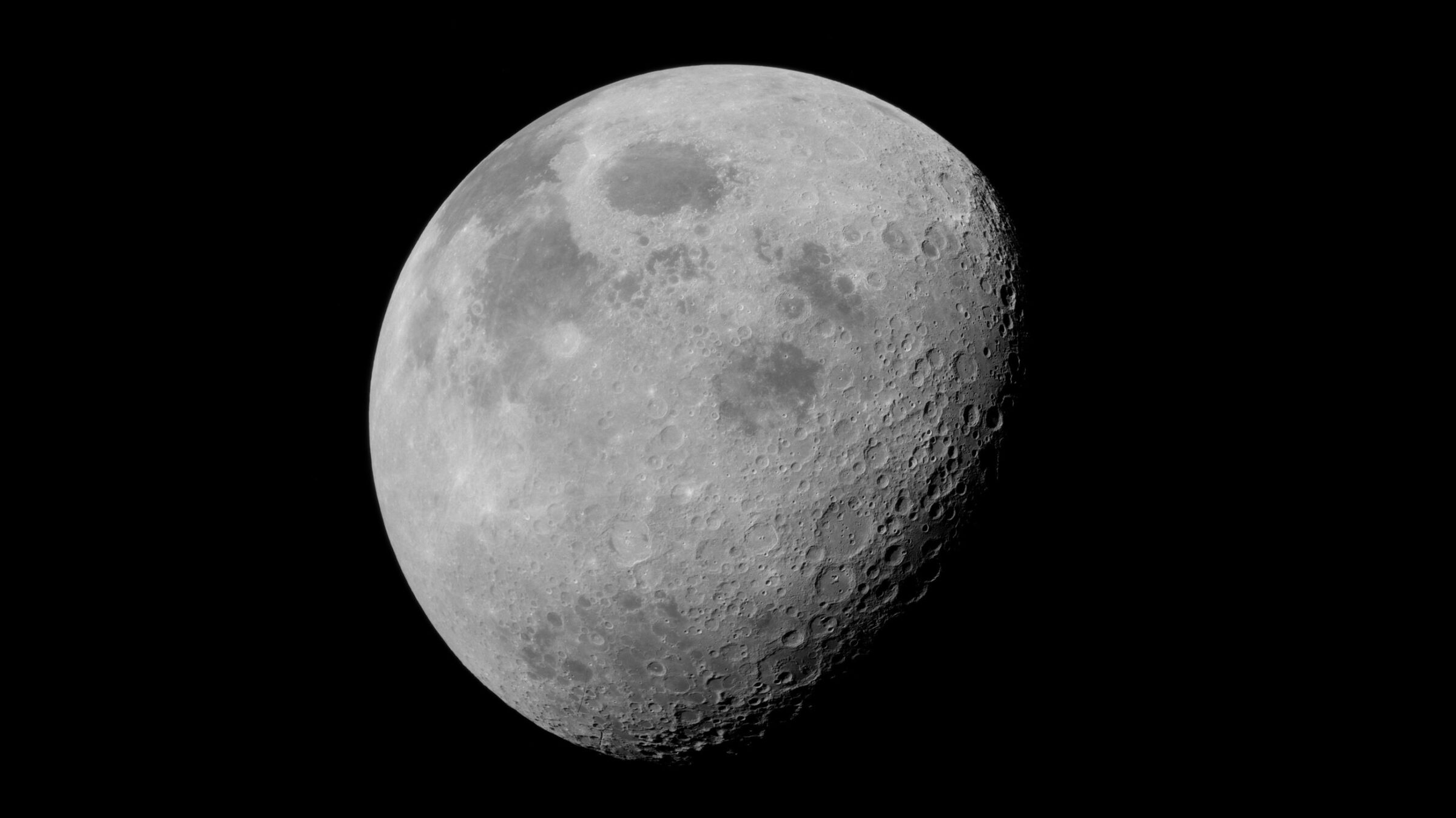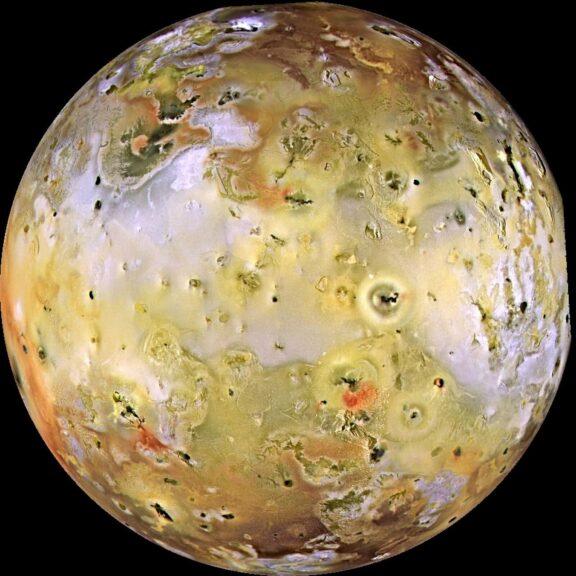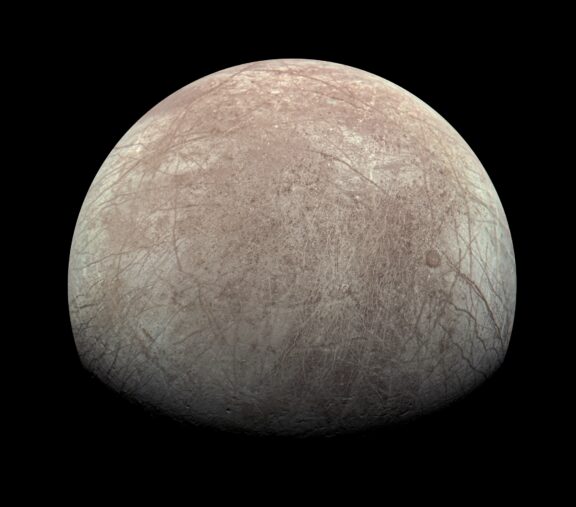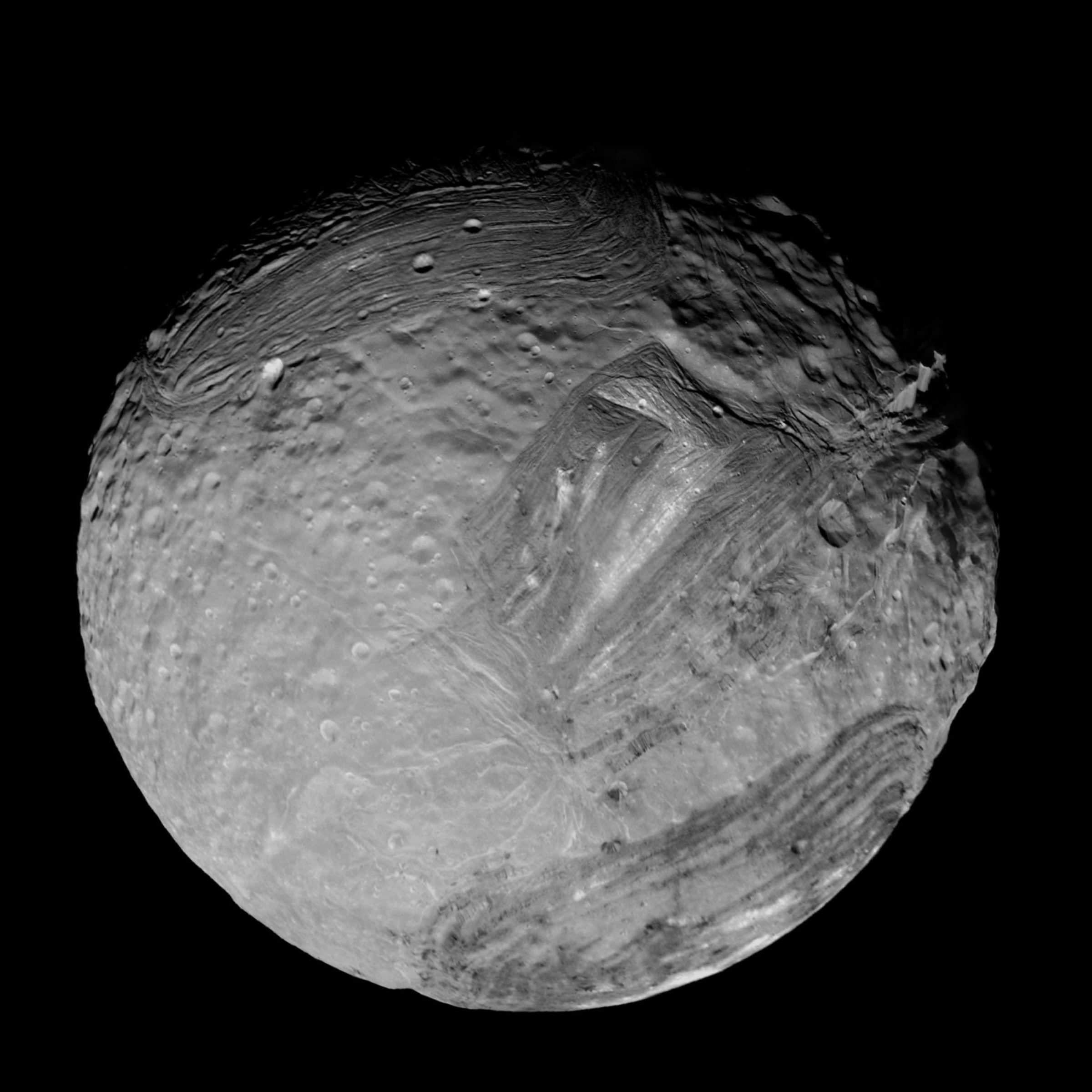Our favorite moons of the Solar System

Written by
Kate Howells
Public Education Specialist, The Planetary Society
February 7, 2023
More than 420 moons are known to exist in our Solar System, and more are being discovered all the time. About 369 of them orbit Jupiter and Saturn, the rest taking their place around other planets and dwarf planets like Pluto. On top of all that, there are also moonlets that orbit smaller objects like asteroids.
It’s hard to choose favorites from among all these wonderful little worlds, but here are eight moons that stand out for their scientific interest and exploratory promise.

Earth’s Moon
Among the scintillating alien worlds in orbit around other planets, Earth’s natural satellite might seem boring. But it’s actually a fascinating place with a dramatic history.
The Moon was formed in the early days of the Solar System, roughly 4.5 billion years ago. The leading theory for the Moon’s formation is that another young planet smashed into the Earth, throwing huge chunks of super-heated rock out into space. Within the span of about a month to a year, some of these chunks came together, attracted to each other’s gravity, and formed the Moon.
The heat generated by the impact, the following rapid accretion, and resulting chemical reactions was likely so intense that the entire surface of the Moon became magma — that is, molten rock. And even though the formation of the Moon only took a matter of months, its surface stayed molten for tens or even hundreds of millions of years.
The Earth would have been very hot from this impact as well, and as the Moon cooled down it did so more quickly on the side facing away from the Earth. (The Moon is tidally locked to the Earth, meaning it always has the same side facing us.) The near side of the Moon developed a thinner crust, through which magma continued to burst until about 50 million years ago. This ongoing volcanic activity is thought to have generated an atmosphere about twice as thick as the current Martian atmosphere. The Moon has since cooled off enough that there are no active volcanoes and no atmosphere at all. But when we look at the Moon, we can still see evidence of its volcanic past. The dark splotches all over the familiar face of the Moon are made of basaltic rock that erupted from volcanoes millions of years ago.

Io
Jupiter’s Io looks about as alien as a world could look: bright yellow with swaths of white and spots of red, brown, orange, and black. Slightly larger than Earth’s moon, Io has mountains taller than Mount Everest and hundreds of volcanoes some of which spew plumes of sulfur and sulfur dioxide, some hundreds of kilometers high. Io is the most volcanically active place in the Solar System, with almost constant eruptions happening all over its surface.
Io is the innermost of Jupiter’s four large moons, alongside Europa, Ganymede, and Callisto. It’s because of this location that Io experiences such intense volcanism. Jupiter is the largest planet in the Solar System, and its large moons are among the biggest of their kind too. As Io orbits Jupiter, sometimes it passes close to some of its neighboring large moons as they go along their own orbits. As these moons pass each other, they pull on each other slightly. This makes all of their orbits around Jupiter a bit uneven. As Io gets closer to and farther from Jupiter, the gravitational ebb and flow distorts the shape of the moon. This squeezing and stretching creates friction. Inside Io, the heat caused by all this friction is enough to melt rock into magma.
About 50 kilometers (more than 30 miles) beneath Io’s surface is an ocean of magma that stretches down another 50 kilometers. As this magma ocean jostles around, it creates enormous volcanic activity on the surface. Io and Earth are the only two worlds in the Solar System known to have large-scale, present-day volcanic activity. And Io far outdoes Earth. Io’s surface is covered in more than 400 active volcanoes, which together produce about 100 times more lava than all of Earth’s volcanoes combined.

Europa
Another of Jupiter’s large moons is Europa. Like Io, Europa orbits close to Jupiter and has sizable moons orbiting beyond it. And so, like Io, Europa gets squeezed by fluctuating gravitational pulls, warming up its interior.
The result of this squeezing, though, is totally different on the two moons because they’re made of different stuff. Unlike rocky Io, Europa has a surface made mostly of solid water ice. So when Europa gets squeezed by getting closer to and farther from Jupiter, the friction created inside the moon heats up the subsurface ice and turns it into liquid water.
The first hint of a subsurface water ocean came from NASA’s twin Voyager probes, which flew through the Jupiter system in 1979. The images they captured of Europa showed the smoothest surface in the Solar System, devoid of big mountains, deep craters, or canyons. This hinted that the solid crust might be on top of a liquid layer, causing the crust to move, split and constantly resurface itself.
Other spacecraft that visited the Jupiter system, like NASA’s Galileo and Juno missions, have collected data from Europa that add to our confidence that liquid water does exist under Europa’s surface. Under an icy shell about 30 kilometers (about 19 miles) thick, Europa may be holding an ocean 70-100 kilometers (or about 40-60 miles) deep. Earth’s oceans, by comparison, only stretch down about 11 kilometers (less than 7 miles) at their deepest. Even though Europa is smaller than Earth’s moon, its oceans are thought to contain twice as much liquid water as all of Earth’s oceans and lakes combined.
This was an exciting discovery because the search for life beyond Earth focuses on places where liquid water can exist, since all known life forms on Earth depend on liquid water.
Europa’s oceans are also thought to be salty, suggesting they make contact with a rocky seabed. This bodes well for the search for life as well, since underwater hydrothermal vents could be a life-giving energy source.
In 2012, the Hubble Space Telescope spotted a huge plume of water erupting from a geyser on Europa’s south pole. The image it captured showed a plume about 200 kilometers (about 125 miles) high. NASA is planning to send its Europa Clipper mission there in 2030, including a specific mission objective to fly through Europa’s plumes. The European Space Agency is also working on its Jupiter Icy Moons Explorer mission (a.k.a. JUICE), which would study Europa along with Ganymede and Callisto starting in 2031. Both of these missions will be able to spend years studying Europa, potentially answering a lot of our most pressing questions about its tantalizingly habitable oceans.

Ganymede
Ganymede is another of Jupiter’s icy moons, and is the largest moon in the Solar System. It’s even bigger than the planet Mercury.
Ganymede is made of rock with a thick outer layer of ice, but unlike Europa it doesn’t show signs of a freshly resurfaced surface. Despite this, the same gravitational squeezing should be happening to some extent on Ganymede, which should warm up its interior.
During its time in orbit around Jupiter from 1995 to 2003, NASA’s Galileo spacecraft measured Ganymede’s magnetic field and found hints that under the surface there might be one or more layers of salty, liquid water. Follow-up observations by the Hubble Space Telescope in 2015 backed up this theory.
Ganymede appears to have several ocean layers, stacked up with layers of ice in between them. The highest level of ice is the crust, which might be about 150 kilometers (about 90 miles) thick. The lowest ocean level could be 800 kilometers (about 500 miles) below that, just above the first layer of the moon’s rocky interior. Altogether, Ganymede likely has the most liquid water of any body in the Solar System. ESA’s JUICE mission will learn a lot about this mega-moon when it visits the Jupiter system in the 2030s.

Enceladus
Enceladus is one of Saturn’s 83 known moons. Small and icy, it wasn’t thought to be of particular importance until the Cassini spacecraft observed it up-close in 2005. As Cassini passed by Enceladus, it saw enormous plumes shooting out of the south pole, larger than any we’ve ever seen coming from Jupiter’s icy moons. Extremely large, active cryovolcanoes were spewing huge amounts of water, ice, and other material into space. Cassini counted more than 100 of the cryovolcanoes in the south pole area alone.
Like Jupiter’s geologically active moons, Enceladus orbits a very massive planet and has other massive moons on either side of it. The other moons tug on Enceladus, making its orbit around Saturn a bit uneven, which then gravitationally squeezes the moon and heats up its interior. The effect this has on Enceladus is enhanced because of its small size.
Enceladus is only about 500 kilometers (about 300 miles) in diameter. Europa, for comparison, is over 3,000 kilometers (more than 1,900 miles) across, and the rest of Jupiter’s major moons are even larger. Because it’s so small, when cracks form in Enceladus’ icy shell and the liquid water beneath gets pushed out, there’s a lot less gravity to hold it down. This allows geysers to reach hundreds of kilometers high.
A lot of this material falls back down as snow, giving Enceladus its bright, white coating. But the lighter particles escape the moon’s weak gravity and get swept up into orbit around Saturn. In fact, Saturn’s widest and outermost ring (called the E ring) is actually mostly made of material that was spewed out of Enceladus’ interior.

Titan
Saturn’s moon Titan is the second-largest in the Solar System, exceeding Mercury in size but not mass. Titan holds some other major standings as well: it is the only moon with a dense atmosphere, the only moon other than our own that a human-made spacecraft has ever landed on, and the only place in the Solar System other than Earth with liquid lakes, rivers, and seas on its surface.
Titan’s atmosphere stretches 100-200 kilometers (about 60-120 miles) high and completely obscures the moon’s surface. It is composed mostly of nitrogen, like Earth’s, along with a large amount of smoggy methane. This methane is thought to be constantly replenished from sources under the moon’s surface. Titan most likely formed with gasses trapped within its icy interior, which are gradually being released to the surface to form its atmosphere.
Methane is also present on Titan in liquid form. Titan is cold enough for methane to behave in much the same way water does on Earth: it rains from the clouds, collects in streams and rivers, erodes the landscape as it runs downstream, settles in lakes and seas, and evaporates to begin the cycle over again. Along with hundreds of smaller lakes, Titan has three large seas about the size of some of North America’s Great Lakes.
NASA’s Cassini spacecraft, which orbited Saturn from 2004-2017, was accompanied by the Huygens lander, provided by the European Space Agency. A few months after Cassini entered into orbit around Saturn, it passed close to Titan and dropped off the Huygens probe. Huygens studied the Titanian atmosphere as it descended, and took images and measurements at its landing site for the rest of its short battery life. Like so many other missions, the discoveries Huygens made sparked even more questions that future missions like NASA’s Dragonfly might be able to answer.

Triton
Triton is the largest of Neptune’s 14 known moons and is thought to be a dwarf planet that was captured by Neptune’s gravity.
The main reason scientists think Triton started off as a dwarf planet is that Triton orbits Neptune the wrong way. If you’re viewing north as the top, Neptune spins counterclockwise on its axis. And because planets and their moons generally all form from the same swirling mass of stuff, the direction of swirl should remain the same — i.e. the moons should orbit the planet in the same direction the planet spins. Because Triton orbits Neptune in a clockwise direction, it’s unlikely that it formed alongside its host planet.
What’s more likely is that Triton formed on its own somewhere in the Kuiper Belt, a huge ring of smaller, icy objects such as comets that orbit the Sun beyond Neptune. Triton likely got gravitationally nudged by another large object into a trajectory that brought it close enough to Neptune to get captured by its gravity and pulled into orbit around the enormous planet. Neptune has fewer moons today than you’d expect for a planet its size, and scientists think it’s likely that when Triton entered the Neptune system it smashed into some of its moons, destroying them, and disrupted others’ orbits with its gravity, causing them to smash into and destroy each other.
When the Voyager 2 spacecraft flew by the Neptune system in 1989, it saw that Triton has fewer craters than expected and has evidence of cryovolcanic activity, with geysers shooting dark material up to several kilometers above the surface. This might suggest that Triton has a layer of liquid water underneath its surface, but having only had one chance to observe it up close, we can’t be sure.

Miranda
Miranda is one of the large moons of Uranus, and is made of a combination of ice and rock. Although it is massive enough to have rounded itself out gravitationally, it’s far from a perfect sphere. Miranda’s surface looks like it’s made up of different pieces stuck together, with wildly varying topographies on each section.
At some of the apparent junctions between sections there are huge cliffs, including the highest cliff in the Solar System, a staggering 20 kilometers (12 miles) high. With extremely low gravity (the whole moon is only a seventh the diameter of Earth’s Moon) if you dropped a rock off the top of this cliff it would take about 10 minutes to hit the ground. Miranda also has enormous canyons, some hundreds of kilometers long and tens of kilometers wide, and reaching 12 times deeper than the Grand Canyon.
Scientists still don’t know why Miranda is the way it is. It’s too small to have internal geological processes causing cliffs and canyons to form, but it’s possible that something happened in the early days of its formation. One theory is that after Miranda coalesced, as it cooled down it froze first on the outside and then on the inside — since water expands as it freezes, the inner layers could have then split apart the outer layers that had hardened first, causing all this jaggedness. Another possibility is that Miranda was smashed apart at some point in the past, but not hard enough to have obliterated it. Instead, the impact might have shattered it into small parts that then came back together gravitationally, reassembling into a sort of Frankenstein’s monster of a moon.
The latest Planetary Science Decadal Survey from the National Academy of Sciences says a Uranus orbiter and probe should be the top priority for NASA’s next new large-scale mission. If NASA follows the Decadal’s advice (which it usually does) a mission to Uranus could launch as soon as 2031, providing an unprecedented opportunity to study Miranda and other fascinating Uranian moons up close.
And more
These are just a few of our favorite moons, but there are many more to explore. Plus, new moons are being found all the time. While this article was being written, 12 tiny new moons were discovered in orbit around Jupiter. And with observing technologies improving all the time, the list will keep growing.
From Mars’ lumpy moons Phobos and Deimos, to Saturn’s dumpling-esque moon Pan and Death Star-esque moon Mimas, to the asteroid moonlet Dimorphos that was smashed by a spacecraft, the moons of our Solar System have plenty in store for those who wish to learn about them.
Support our core enterprises
Your gift today will go far to help us close out the year strong and keep up our momentum in 2026.
Donate

 Explore Worlds
Explore Worlds Find Life
Find Life Defend Earth
Defend Earth

